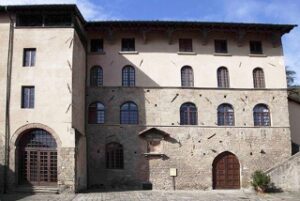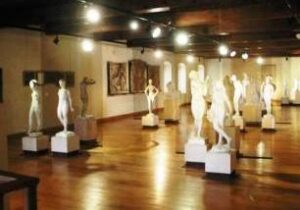Ferraia, old Pescia
4-hour visit
Itinerario: Via Pacini – Via Cairoli – Piazzetta S. Romualdo – Via delle Capanne, Palagio – Mulattiera per il Monte – Chiesa di S. Domenico – Chiesa e Convento di S. Francesco di Paola in castello – Piazza S. Stefano – Palazzo Galeotti – Prioria dei Santi Stefano e Niccolao – Piazza Obizzi – Palazzo Magnani – Palazzo Martelli – Ruga degli Orlandi – Chiesa della SS. Annunziata – Chiesa e convento di S.Giuseppe – Palazzo Forti.
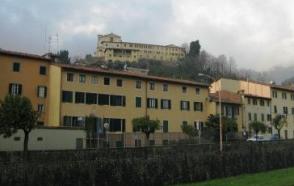
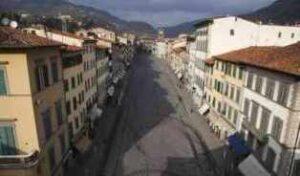
Go over St. Francis bridge and before reaching Via Giovanni Pacini, enjoy the town from a different viewpoint: the Pescia riverís loop, the beautiful palacelined Forti boulevard with the magnificent palaces overlooking the ancient grande piazza. Isnít it a great view? Water has always played a key role for the town, in fact, besides the river, the area we are going to visit is characterized by a network of canals called “goreî by Pesciatins, artifical stretches of water, both subterranean and embedded in-between houses, overlooked by some pretty buildings.The “gora”, was then used to facilitate every-day and trading purposes.
A glance upward at the hilltop. There sits the Castello di Bareglia by the Cadolingi Counts, gently nestled on the green hill ridge. This is the most ancient monument in town going back to 11th century. Originally it was the Cadolingi countsí stronghold till 1113 when it became property of Luccan bishops. Unfortunately the ancient fortified defensive walls are destroyed now, apart from a few architectural remnants in the back Letís carry on our stroll downtown. Walk past the traffic-light up the main street, on your right search for number 35. There stands the beautiful 18th-century palace of the Vanni family, later Puccinelli-Sannini. On the facade admire the noteworthy framed windows and the string-courses; on the corner you can see the Puccinellis’ imposing armorial bearings. Opposite at number 54 is the palace of the Abbot Carlo Cecchi, famous as a diplomat for helping to raise the Church of Pescia to episcopal dignity in march, 17th 1727. The emblem or armorial bearings of the landlord, the Cecchi family, stands boldly out on the lintel in the upper facade. Strolling northward along Cairoli street, notice the peculiar passages and tiny tunnels at either street side. They are commonly called cantini; the first on your right is Canto di Meino which leads to Bareglia Castle along a narrow country lane.
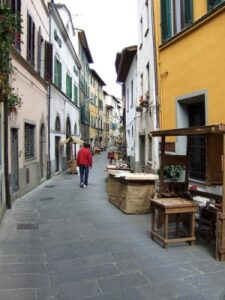
A glance upward at the hilltop. There sits the Castello di Bareglia by the Cadolingi Counts, gently nestled on the green hill ridge. This is the most ancient monument in town going back to 11th century. Originally it was the Cadolingi countsí stronghold till 1113 when it became property of Luccan bishops. Unfortunately the ancient fortified defensive walls are destroyed now, apart from a few architectural remnants in the back Letís carry on our stroll downtown. Walk past the traffic-light up the main street, on your right search for number 35. There stands the beautiful 18th-century palace of the Vanni family, later Puccinelli-Sannini. On the facade admire the noteworthy framed windows and the string-courses; on the corner you can see the Puccinellis’ imposing armorial bearings. Opposite at number 54 is the palace of the Abbot Carlo Cecchi, famous as a diplomat for helping to raise the Church of Pescia to episcopal dignity in march, 17th 1727. The emblem or armorial bearings of the landlord, the Cecchi family, stands boldly out on the lintel in the upper facade. Strolling northward along Cairoli street, notice the peculiar passages and tiny tunnels at either street side. They are commonly called cantini; the first on your right is Canto di Meino which leads to Bareglia Castle along a narrow country lane.
Short, yet once glamorous and elegant, Via Cairoli is lined with noteworthy palaces, for example, the Gardini family’s at number 44. Keep strolling along Oberdan Street to the small square, Piazzetta S. Romualdo or del ì Crocifissino. Walk northwards past the square Moro di Bareglia, here starts a scenic, and quite demanding, walk outside the walls along the old lane to Santa Margherita. From the top among the leafy branches of imposing olive trees you’ll get the reward: a real suggestive bird’s-eye view of the entire town. Indeed a walk you certainly don’t want to miss if you have enough energies and stamina.
Back from piazzetta di S. Romualdo, carry on the historical-artistic discovery walk starting from the square della Bareglia. This is the heart of old Pescia; the main street is lined with tiny houses one against the other. At the end of Via Gugliemo Oberdan, on your right, take the steep lane leading to one of the most noteworthy artworks in town, the Palagio, the elegant, recently-restored (various times intervention) 13th-century seat of the podest, a chief magistrate of the Italian republics in the middle ages. On the front the 19th-century picture illustrates an important historical event, when 17th February 1362 Pisans and Luccans tried to reconquer Pescia, but were defeated by Pesciatins. In the painting you can recognize St. Stefan bell-tower, which is here celebrated as the bells rang to alert the countryside and the town was safe under Florence. It was the day of St. Policronius. Since then, this day was dedicated to the Saint Bishop and Martyr. On the second floor the interesting gipsoteca Libero Andreotti, an important plaster cast museum by Andreotti, Pesciaís illustrious citizen and one of the most influential Italian sculptors in the early 20th century. Walk through the Canto di S. Policronio below the Palagio, and take time to stroll along the mule track up to Monte a Pescia. Take the road ont the right to the Convento of San Domenico, an important convent of early 1600s, one of the highlights in town. The church is dated around 1670s and particularly notable is the precious Baroque altarpiece by Benedetto Orsi which creates impressive visual effects. In the middle stands a marvellous, richly-decorated ciborium with a painting by Carlo Maratti, an Italian painter of High Baroque, representing The Appearance of the Virgin to St. Philip Neri (1675) Back to the mule-track heading to the village of Monte a Pescia, you may want to turn left to the Casa di Nazaret, once the convent of Saint Francis of Paola, but the walk up is quite demanding. The church facade by Antonio Tani (1719) is lovely decorated with architectural mouldings; a quick step inside, worth visiting are splendid 18th-century paintings such as Madonna e Santi by Benedetto Orsi and Innocenzio Ansaldiís painting representing Saint Andrew Avellinoís death.
Time to go back to town. From below the Palagio admire the front of the chiesa dei Santi Stefano e Niccola which, like all medieval religious buildings, is west-oriented. Raised to episcopal dignity in 1500s, this church could tell a lot of stories connected with the Pesciatin community. It dates back to 13th century, but its original medieval plant has been completely transformed by the later changes, especially in the 16th century. A visit inside is worthwhile for the numerous paintings and canvas decorating impressive altarpieces. The church boasts exquisite choir paintings: the Virgin Mary and the Saints of end 15th century and Virgin Mary with Child of 1300s. The central canvas in the apse by Alessandro Bardelli represents the Virgin Mary with the Patron Saints of Pescia; below is a picture of the town. On the right altarpiece is a splendid wooden crucifex of 1300s.
The square piazza S. Stefano is bordered west by palazzo Magnani and east by palazzo Cecchi. A narrow street takes you to the nearby piazza Obizzi with the mentioned palazzo Magnani, which today houses the communal offices, and opposite the imposing Renaissance-style palazzo dei Martelli showing off its splendid marble apparatus to the trabeated windows. Despite their Baroque or Renaissance fronts, Pesciatin palaces preserve the original vertical-structure of medieval tower-houses. From Piazza Obizzi, turn left, and strolling northwards youíll get to the characteristic via dei Forni; on the right ( number 11) is the palazzo degli Orlandi which in 1211 hosted Saint Francis of Assisi as the memorial tablet says.
Back towards piazza Obizzi, we recommend reaching the main street called Ruga degli Orlandi, probably the most charming in the city centre despite the cars parked at either side.
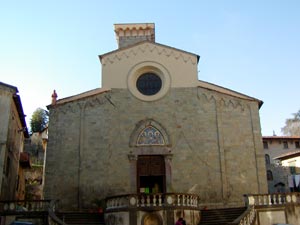
Line d with great palaces whose fronts boast imposing armorial bearings, its peculiar name Ruga (from latin ìrugaî, ìfurrowî) may be due to its etching lengthwise the city. On the right, packed between palaces, is the early 16th-century Pieve della Santissima Annunziata with its bare front and a niche with St. Paul, the Barnabitesí protector. Strangely enough, the church played a key role in the artistic and religious history of the town.
A glance up at the high altar, and you’ll spot the stem of the town. Look at Carlo Sacconiís painting, between the two pilaster strips of the apse, it represents the town symbolically thanking the Virgin Mary for defeating the plague. Step inside to marvel at the architectures great visual effect, especially for the numerous decorative vault-bordering plasters. Look down at your feet, at the grand 19th-century marble floor, probably the only one left in Pescia. Before leaving, admire the famous wooden crucifex venerated by Pesciatins in memory of the deadly plague whose death toll was very high in the 20s of 1600s.
Once out of the church, turn left past via del Ghiaccio and up Ontanatico hill along the lvia di S. Giuseppe to the homonymous convent built in 1648, a retirement home today. A quick look The interior is not very interesting, apart from the interesting Baroque altars, but a view of unsurpassed beauty is offered by the church square Head back to the Ruga degli Orlandi. On the left at numbers 42-44, find the most original aristocratic palace in town, the Forti familyís. Its Baroque front scattered with vibrant and harmonious cornices made of pietra serena outlining the windows is a real splendour! At the Rugaís farthest end, the road splits up in two distinctive areas: right is the piazzetta del Ghiaccio, and left the most picturesque city centre.Wander at leisure
Interno ed esterno Palazzo del Podestà – Gipsoteca Libero Andreotti
